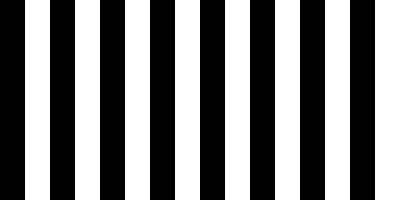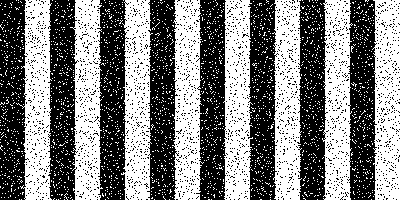Introduction
Can some phenomena be so complex that there cannot be an understandable explanation for it? If so, could systems like brains and economies harbor such phenomena?
Bar Code
In his 1991 paper
Real Patterns,
Dennet outlines a concrete challenge to the concept of pattern. He defines a
pattern of pixels called Bar Code where in each row, there is a repeating
occurence of 50 black pixels and then 50 white pixels. This Python program
generates all of the Bar Code instances that appear later, with adjustments to
the noise variable:
from PIL import Image, ImageDraw
import random
random.seed()
noise = 0.1
stripeWidth = 50
width = 400
height = 200
image = Image.new('RGBA', (width,height), (0,0,0,0))
draw = ImageDraw.Draw(image)
black = (0,0,0, 255)
white = (255,255,255, 255)
for x in range(width):
for y in range(height):
value = None
value = x % stripeWidth < stripeWidth/2
if random.random() <= noise: value = not value
color = black if value else white
draw.point((x,y), fill=color)
image.save('barcode_noise={0}.png'.format(noise))
Simple enough. Here is a instance of Bar Code:

Of course, this is a perfect instance of Bar Code. That is, this instance has no noise that is not accounted for by the definition of Bar Code. Consider the following image:

This image is an instance of Bar Code with 10% random noise. The random noise is generated in the following way: each pixel in a perfect instance of Bar Code has a 10% chance of being flipped to the opposite color. Though the noise distorts the predictions that Bar Code yields about each pixel, Bar Code still seems like it can be a meaningful description.
The following array shows instances of Bar Code ranging in the amount of random noise.

A phenomenon becomes clear: as the noise increases, Bar Code becomes a less and less useful way to recognize the image. At 50% noise in fact, it is mathematically equivelant to describe the image as “50% noise” as it is to describe it as “Bar Code with 50% noise” (in terms of predicting pixel values). At close to 50% noise, perhaps there is a better pattern than Bar Code at more accurately describing the pixels.
Dennet uses this demonstration to show how the concept of patterns relies on something beyond a priori definitions — a pattern does not exclusively relate to its perfect instances. Ultimately, Dennet argues that patterns can be instantiated to varying degrees based on their usefulness relative to the ovserver. For example, patterns can present trade-offs in accuracy (how often the pattern makes correct predictions) versus simplicity (how consisely the pattern’s definition can be stated and measured) that must be weighed relative to the purpose for using the pattern.
My argument will be along similar lines, analogizing to the trade-offs made in scientific patterns to build explanations at varying levels of abstraction.
Levels of Abstraction
Fields of scientific study can be organized into a abstraction-tree, where the leaves of the tree are the most precise and the deeper branches are abstractions of their children. Imagine the following as one path in this tree, in order of increasing abstraction: physics, chemistry, biology, psychology, sociology, political science. I will use the step between physics and chemistry as a canonical example. Chemistry is an abstraction of physics — chemistry entirely depends on and is predicted by physics, but does not consider all of the details that physics considers.
Why? Because chemistry yields explanations at a higher level of analysis than physics. When a chemist describes that a chemical reaction with certain proportions of reactants, they do mean something translatable to the language of physics. They importantly omit things like the mechanics and inner workings of individual atoms in order to give a simple explanation. It is simple because it reduces the complexity of the calculations needed to make predictions about the result of the reaction at chemistry’s level of analysis.
If asked to make predictions about things like the tradjectories of individual atoms, the chemical explanation is not much if at all better than random noise. So in order to rise to a higher level of abstract terms, chemistry forgoes explanatory power at lower levels like physics.
But why does chemistry consist of the abstractions that it does in fact consist of? Many of the chemistry-abstractions, in fact, must contend with trade-offs such as accuracy vesus simplicity. Many chemistry-abstractions have exceptions that are unaccounted for in chemical terms and must be explained in physical terms — at the chemical leve, they are treated as unexplainable. This is because the chemical terms sometimes forfeit explanatory power over the lower level that are necessary for describing certain phenomena at the chemical level. For example, perhaps a chemical reaction is affected by the quantum properties of its contents. Quantum mechanical examplations are at a lower-level of description that cannot mention chemistry-abstractions because the explanations depends on properties of the referents of the chemistry-abstractions that are left ambiguous.
The reason, however, that chemistry is successfully and meaningly separate from physics is that chemistry-abstractions are useful enough. Among other things, chemistry-abstractions have enough precision and accuracy to be scientifically pragmatic. If chemistry did not have these properties, it would probably follow the fate of so many other proto-scientific fields that dwindled as exceptions built up.
In chemistry so far, the abstractions have been useful enough. But it is imaginable that one day (perhaps alread), there will be discovered some phenomenon that no chemical explanation can give a better-than-noise account of. This would have to be a phenomenon that exists at the level of chemical analysis, yet has no explanation via chemical terms. There are two possible solutions: take theory from physics in order to explain it (if there is such an explanation), or introduce the explanation as an assumption.
When There is No Explanation
But what exactly does something like this look like? Let’s consider the example of economics. Why does my bread cost $4? There may in fact not be a useful explanation at the level of micro-economics.